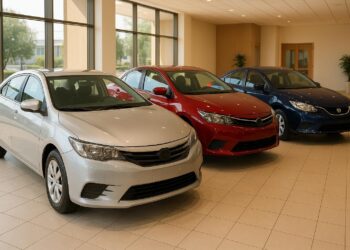Did you know? Brake failure accounts for 18% of highway accidents in Kenya, with rough roads, steep slopes, and seasonal weather accelerating wear and tear by up to 40%. Proper brake care can save lives and reduce costly repairs. Here’s what you need to know:
- Understand Road Impact: Kenyan roads, especially unpaved ones, wear out brakes faster. Coastal areas face corrosion, while hilly regions like Limuru cause overheating.
- Check Brake Fluid: High humidity degrades brake fluid 30% faster. Inspect it every 3 months and replace it annually in coastal regions.
- Replace Parts on Time: Urban drivers should change brake pads every 20,000km, while rural drivers can wait until 30,000km.
- Prevent Overheating: Use engine braking on steep descents and take cooling breaks to avoid accidents caused by heat-stressed brakes.
- Seasonal Maintenance: Rainy seasons require frequent checks for water damage, while dry seasons demand dust removal to maintain efficiency.
Quick Tip: Invest in DOT 4 brake fluid for better heat resistance and consider professional inspections every 6 months for urban drivers or quarterly for those on rugged routes.
These tips can help you navigate Kenya’s challenging roads safely and keep your brakes in top condition.
Related video from YouTube
1. How Kenya’s Roads Impact Your Brakes
Kenya’s road conditions heavily influence the wear and tear on vehicle brake systems. With over 91% of the country’s roads being unpaved, vehicles endure faster brake wear than usual. The 2024 KevTech Auto Garage Service Report emphasizes the need for more frequent brake maintenance in such environments [4].
The effects vary by region, as shown in service center data:
| County | Road Condition | Recommended Service Frequency |
|---|---|---|
| Nairobi | Poor (2.1/5) | 18 months |
| Makueni | Very Poor (1.7/5) | 14 months |
Mountainous areas like Limuru and Mount Kenya add another layer of difficulty. These routes expose brakes to extreme heat, leading to rotor warping and pad glazing – issues that reduce braking efficiency. Regular inspections are critical, especially before driving through highland regions.
Coastal areas bring their own challenges. In Mombasa, the mix of salty air and humidity increases brake corrosion by 40% compared to inland locations [5]. This corrosion, combined with wear from rough roads, makes maintenance even more important. Auto-Xpress advises quarterly anti-corrosion treatments to safeguard brake line coatings and caliper slide pins [3].
Dry seasons also take a toll on brake systems. Fine dust particles infiltrate components, cutting braking efficiency by 15-20% and speeding up wear on fluid and hydraulic parts [4]. Common issues during this period include:
- Reduced braking power (15-20% efficiency loss)
- Contaminated brake fluid
- Faster damage to hydraulic components
Overloaded matatus with drum brakes often struggle on steep roads, contributing to accidents and underscoring the need for properly suited braking systems [1][4].
2. Monitor and Change Brake Fluid
Kenya’s tough road conditions make keeping your brake fluid in top shape critical to avoiding system failure. The 2024 Automotive Doctor Motor Garage Report highlights that Kenya’s high humidity speeds up brake fluid deterioration by as much as 30% compared to cooler climates [7].
It’s recommended to check your brake fluid every 3 months or after 5,000km. However, specific regions in Kenya require different maintenance schedules:
| Region | Maintenance Guidelines |
|---|---|
| Coastal Areas | Inspect monthly; replace fluid annually |
| Inland Areas | Inspect quarterly; replace every 24 months |
| Heavy-Duty Use | Inspect monthly; replace every 15-18 months |
For Kenyan roads, DOT 4 brake fluid is a better option than DOT 3. With a dry boiling point of 230°C (compared to DOT 3’s 205°C), DOT 4 handles the heat generated on steep routes like Mai Mahiu-Narok or the tea-growing highlands of Western Kenya [4]. This higher resistance to heat is especially important during long downhill drives.
A 2023 Naivasha accident investigation revealed how contaminated brake fluid led to a complete hydraulic pressure failure during a descent [1]. Warning signs include darkened fluid, spongy brake pedals, visible contaminants, or dashboard alerts [5].
Professional services often include moisture content testing using specialized tools, which is particularly useful during Kenya’s rainy season (March-May) [7].
"Regular brake fluid maintenance isn’t just about keeping the levels up. In Kenya’s tropical environment, testing the fluid’s quality at every service is crucial. A simple moisture test can prevent major brake failures, especially on our challenging roads", advises AutoMag.co.ke’s technical expert.
Replacing brake fluid annually costs around Ksh 3,000-5,000 at certified garages. Neglecting this maintenance could lead to repairs exceeding Ksh 50,000 [2].
3. When to Replace Brake Parts
Maintaining brake fluid is crucial, but knowing when to replace the physical components is just as important. The 2024 Nairobi Traffic Safety Report highlights that vehicles with delayed brake pad replacements face a 73% higher accident risk during sudden stops [1]. Kenya’s rugged roads often require more frequent replacements than what manufacturers typically suggest.
Here’s a breakdown of recommended replacement intervals based on driving conditions in Kenya:
| Component | Urban Areas | Rural/Highway | Commercial/Steep Terrain Use |
|---|---|---|---|
| Brake Pads | 20,000 km | 30,000 km | 15,000 km |
| Rotors | 50,000 km | 70,000 km | 40,000 km |
| Drum Shoes | 32,000 km | 48,000 km | 24,000 km |
Warning Signs to Watch For
Be alert to these signs that your brake system needs immediate attention:
- Visual Clues: Brake pad thickness less than 3mm, visible through the wheel spokes [3].
- Noises: High-pitched squealing from wear indicators or grinding sounds from metal-on-metal contact [6].
- Performance Issues: A sinking brake pedal or noticeable vibrations while braking [7].
Notably, 68% of brake failures nationwide stem from worn-out components [6].
"Our analysis shows that delaying brake pad replacement by just 5,000 kilometers beyond recommended intervals increases repair costs by 400% due to rotor damage", says an Automotive Doctor technician [5].
Drum Brakes vs. Disc Brakes
Drum brake systems tend to last 60% longer than disc brakes in Kenyan conditions. However, they’re particularly vulnerable during the rainy season. Rainwater trapped in drum housings can speed up wear and compromise parking brake performance, especially on inclined surfaces [4].
Cost of Replacement in Kenya
Here’s an overview of typical costs for brake component replacements:
| Service | Original Manufacturer Parts | Quality Aftermarket | Labor |
|---|---|---|---|
| Brake Pad Replacement | KES 6,500-9,000 | KES 3,800-5,200 | KES 2,000-3,500 |
| Complete Rotor Replacement | KES 18,000+ | KES 12,000-15,000 | KES 4,000-6,000 |
Inspection Frequency
Urban drivers should schedule professional brake inspections every six months, while those frequently navigating challenging routes like Thika Highway are advised to check quarterly [1][2].
sbb-itb-e5ed0ed
4. Prevent Brake Overheating on Hills
Managing heat effectively is crucial when driving on Kenya’s steep slopes, especially considering that 18% of accidents in Kenya are brake-related. During prolonged descents, brake temperatures can exceed 600°C, putting vital components under extreme stress [1].
Engine Braking Techniques
Using engine braking is one of the best ways to control heat buildup. For vehicles with manual transmissions, select a lower gear before starting your descent. Keep the engine speed between 2000-2500 RPM (usually 3rd gear for sedans) and downshift gradually. This method can reduce brake pad usage by up to 60%, according to Automotive Doctor technicians [2].
If you drive an automatic, use the "L" or "2" gear settings on slopes longer than 1km. It’s also important to turn off cruise control when navigating long descents [7].
Strategic Cooling Stops
On extended downhill stretches, such as those on the Nairobi-Nakuru highway, take cooling breaks every 5-7km if you notice heat-related issues. Let your brakes cool for 15-20 minutes to avoid further damage [9]. Cooling stops are especially necessary if you experience:
- A soft or unresponsive brake pedal
- A burning smell
- Reduced braking performance
Warning Signs and Immediate Actions
If you encounter brake problems during a descent, act quickly to avoid failure. Here’s a quick guide:
| Warning Sign | Required Action | Why It Matters |
|---|---|---|
| Burning smell | Engage hazards, stop safely | Prevents brake pad breakdown |
| Blue-tinted rotors | Take an immediate cooling break | Avoids permanent rotor damage |
| Spongy brake pedal | Shift to a lower gear immediately | Reduces the chance of failure |
"Our analysis shows that responding to early warning signs prevents 89% of complete brake failures on steep descents", says an Automotive Doctor specialist [1].
Load Management
For commercial vehicles and matatus, balancing the load is vital. Placing more than 70% of the weight on the rear axle increases brake strain by 40% during descents [9]. This is particularly problematic in areas like Likoni Ferry, where salt air adds extra stress. In fact, 35% of truck breakdowns at the ferry are brake-related [4].
Drivers who frequently navigate hilly terrain should consider specialized upgrades, such as vented rotors, available at select garages. Seasonal weather changes can also impact braking performance, which we’ll explore further in the next section.
5. Brake Care in Wet and Dry Seasons
Kenya’s diverse terrain already poses challenges for vehicle brakes, but seasonal weather changes add another layer of complexity. While driving in hilly areas tests your brakes’ heat resistance, wet and dry conditions demand specific maintenance strategies to keep your braking system reliable.
Rainy Season Protection
Water can seep into the brake system, lowering brake fluid’s boiling point by 30-40%, which can drastically affect stopping power [7]. After driving through floods, pump the brakes 5-6 times to dry out the rotors and restore proper function [7]. These steps, combined with regular fluid checks, help address weather-related risks.
Here are some key pre-rain season inspections recommended by Automotive Doctor:
| Inspection Point | Frequency | Actions to Take |
|---|---|---|
| Drainage holes | Monthly | Clear debris to prevent water buildup |
| Brake fluid | Bi-weekly | Check for contamination |
| Rotor surfaces | After floods | Inspect for rust or wear lines |
Dry Season Maintenance
Kenya’s red soil dust, which can reduce braking efficiency by 15-20% (as noted earlier), makes ceramic brake pads a smart choice for dry conditions. Adjust your maintenance routine based on your region:
- Coastal Wet Seasons: Perform weekly caliper checks and remove dust monthly.
- Inland Dry Seasons: Clean components bi-monthly and replace brake fluid before rains begin.
Coastal drivers, especially in areas like Mombasa, face added challenges from salt-laden air and humidity. Frequent light braking during wet conditions can cause pad glazing [3]. To avoid this, maintain a longer following distance and use moderate, steady braking pressure.
Professional Maintenance Tips
Avoid these common seasonal mistakes to keep your brakes in top condition:
- Applying WD-40 to rotors, which reduces friction and compromises braking [2].
- Ignoring spongy pedals, which could signal air in the brake lines [5].
- Over-tightening dust covers, as this can trap moisture and lead to corrosion [4].
For extra protection during wet conditions, consider using hydrophobic brake fluid treatments. These can improve wet braking performance by up to 15% [6].
Disc vs Drum Brakes Comparison
For Kenyan drivers navigating varied road conditions, choosing between disc and drum brakes can make a big difference in safety and maintenance. Data from Thika Superhighway shows that vehicles with disc brakes experience 23% fewer brake-related incidents during rainy seasons [1][7]. This highlights how brake systems can directly affect performance in challenging weather.
Performance Characteristics
| Feature | Disc Brakes | Drum Brakes |
|---|---|---|
| Component Lifespan | Up to 80,000 km [3] | 50,000-60,000 km [3] |
| Heat Dissipation | 40-50% better cooling [9] | Limited by enclosed design |
| Wet Performance | Quick water shedding | Reduced stopping power |
| Dust Resistance | Moderate | Better suited for unpaved roads [5] |
| Initial Cost | Ksh 25,000 average [3] | Ksh 15,000 average (30-40% cheaper) [5] |
These features mean that the right brake system often depends on the driving environment, as discussed in earlier sections.
Maintenance Requirements
Maintenance needs and costs differ significantly between the two systems. Here’s a breakdown of common tasks:
| Maintenance Task | Disc Brakes | Drum Brakes |
|---|---|---|
| Component Replacement | Rotor resurfacing: Ksh 2,000-5,000 [8] | Drum replacement: Ksh 3,500-6,000 [5] |
| Adjustment Frequency | Minimal adjustment required | Requires adjustment every 10,000 km [5] |
Regional Considerations
In Kenya, many commercial vehicles use a combination of front disc and rear drum brakes. This setup balances the stop-and-go demands of urban areas like Nairobi with the durability needed for rural roads.
"Front-disc/rear-drum combinations balance Nairobi’s stop-and-go needs with rural durability", says Automotive Doctor [2][8].
For coastal drivers, drum brakes offer 18% better durability in salt-air conditions, though they come with higher maintenance needs [5].
Conclusion
By following these five maintenance tips – like keeping an eye on fluid levels and adjusting for seasonal changes – drivers can lower the chances of brake issues on Kenya’s varied roads.
Kenya’s unique climate calls for specific brake care. For instance, vehicles often used on rural roads should have their brake pads checked every 5,000 kilometers, as dust and debris can speed up wear [3].
As highlighted in the disc vs. drum brake comparison, selecting the right system for your driving needs is key to safety. Front-disc brakes work especially well in Nairobi’s urban settings, helping manage longer stopping distances during the rainy season [6].
Related Blog Posts
- Essential Car Maintenance Checklist for Rainy Season
- 7 Tips for Rainy Season Car Care in Kenya
- Ultimate Guide to Off-Road Safety in Kenya
- Ultimate Guide to Car Maintenance Budgeting in Kenya




